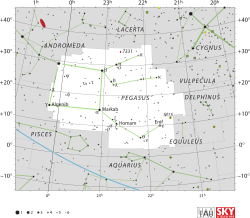Mu Pegasi

| |
| Observation data Epoch J2000.0 Equinox J2000.0 | |
|---|---|
| Constellation | Pegasus |
| Right ascension | 22h 50m 00.19315s[1] |
| Declination | +24° 36′ 05.6984″[1] |
| Apparent magnitude (V) | 3.514[2] |
| Characteristics | |
| Spectral type | G8 III[3] |
| U−B color index | +0.674[2] |
| B−V color index | +0.932[2] |
| Astrometry | |
| Radial velocity (Rv) | +13.54 ± 0.20[4] km/s |
| Proper motion (μ) | RA: +144.70[1] mas/yr Dec.: –41.87[1] mas/yr |
| Parallax (π) | 30.74 ± 0.27[1] mas |
| Distance | 106.1 ± 0.9 ly (32.5 ± 0.3 pc) |
| Absolute magnitude (MV) | 0.432[5] |
| Details | |
| Mass | 1.3[6] M☉ |
| Radius | 9.6 ± 0.4[7] R☉ |
| Surface gravity (log g) | 2.50[3] cgs |
| Temperature | 4,950[3] K |
| Metallicity [Fe/H] | –0.03[3] dex |
| Rotational velocity (v sin i) | 4.0[8] km/s |
| Other designations | |
Mu Pegasi (μ Peg, μ Pegasi) is a star in the northern constellation of Pegasus. It has the traditional name Sadalbari, which derives from the Arabic term for "luck star of the splendid one".[10] The apparent visual magnitude of this star is 3.5,[2] which is bright enough to be seen with the naked eye even on a moonlit night. The distance to this star can be determined with parallax measurements, which yields a value of 106.1 light-years (32.5 parsecs).[1]
The spectrum of this star matches a stellar classification of G8 III.[3] The luminosity class of 'III' means that it has exhausted the hydrogen fuel at its core and evolved into a giant star. It is slightly more massive than the Sun, but has expanded to nearly ten times the Sun's radius.[7] (Mishenina et al. (2006) list it with an estimated 2.7 times the mass of the Sun.[5]) The effective temperature of the outer atmosphere is about 4,950 K,[3] which is cooler than the Sun and gives it the yellow hue of a G-type star.[11][12] The abundance of elements other than hydrogen and helium, what astronomers term the metallicity, is similar to the abundance in the Sun.[3]
References
- 1 2 3 4 5 6 van Leeuwen, F. (November 2007), "Validation of the new Hipparcos reduction", Astronomy and Astrophysics 474 (2): 653–664, arXiv:0708.1752, Bibcode:2007A&A...474..653V, doi:10.1051/0004-6361:20078357
- 1 2 3 4 Jennens, P. A.; Helfer, H. L. (September 1975), "A new photometric metal abundance and luminosity calibration for field G and K giants.", Monthly Notices of the Royal Astronomical Society 172: 667–679, Bibcode:1975MNRAS.172..667J, doi:10.1093/mnras/172.3.667
- 1 2 3 4 5 6 7 Frasca, A.; et al. (December 2009), "REM near-IR and optical photometric monitoring of pre-main sequence stars in Orion. Rotation periods and starspot parameters", Astronomy and Astrophysics 508 (3): 1313–1330, Bibcode:2009A&A...508.1313F, doi:10.1051/0004-6361/200913327
- ↑ Famaey, B.; et al. (January 2005), "Local kinematics of K and M giants from CORAVEL/Hipparcos/Tycho-2 data. Revisiting the concept of superclusters", Astronomy and Astrophysics 430 (1): 165–186, arXiv:astro-ph/0409579, Bibcode:2005A&A...430..165F, doi:10.1051/0004-6361:20041272
- 1 2 Mishenina, T. V.; et al. (September 2006), "Elemental abundances in the atmosphere of clump giants", Astronomy and Astrophysics 456 (3): 1109–1120, arXiv:astro-ph/0605615, Bibcode:2006A&A...456.1109M, doi:10.1051/0004-6361:20065141
- ↑ Smith, G. (November 1998), "Stellar atmospheric parameters for the giant stars MU Pegasi and lambda Pegasi", Astronomy and Astrophysics 339: 531–536, Bibcode:1998A&A...339..531S
- 1 2 Nordgren, Tyler E.; et al. (December 1999), "Stellar Angular Diameters of Late-Type Giants and Supergiants Measured with the Navy Prototype Optical Interferometer", The Astronomical Journal 118 (6): 3032–3038, Bibcode:1999AJ....118.3032N, doi:10.1086/301114
- ↑ Massarotti, Alessandro; et al. (January 2008), "Rotational and Radial Velocities for a Sample of 761 HIPPARCOS Giants and the Role of Binarity", The Astronomical Journal 135 (1): 209–231, Bibcode:2008AJ....135..209M, doi:10.1088/0004-6256/135/1/209
- ↑ "48 Peg -- High proper-motion Star", SIMBAD (Centre de Données astronomiques de Strasbourg), retrieved 2012-01-28
- ↑ Allen, Richard Hinckley, (1963) [1899]. Star Names: Their Lore and Meaning (rep. ed.). New York, NY: Dover Publications Inc. pp. 328–29. ISBN 0-486-21079-0.
- ↑ "The Colour of Stars", Australia Telescope, Outreach and Education (Commonwealth Scientific and Industrial Research Organisation), December 21, 2004, retrieved 2012-01-16
- ↑ Kaler, James B., "SADALBARI (Lambda and Mu Pegasi)", Stars (University of Illinois), retrieved 2012-01-28
| ||||||||||||||||||||||||||||||||||